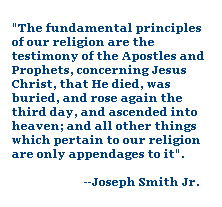Synopsis of the Book of Mormon
The Book of Mormon really begins with the Jaredites and the Book of Ether which is the second to last book. The Jaredites are a small group of Christians who lived after the flood in Babel of Babylon about 2000 BC. The Jaredites pray that God would not confound their language. God makes a covenant with them to give them the land of promise, a land even better than the fertile cresent. What land could be better than the trigis-eurphrates river valley? Well, if this group had the words from Adam to Noah, they would know about the land the Patriarchs lived in before the flood. They would have known about America. During their preparation to travel to America, the Brother of Jared sees the pre-mortal Jesus Christ and they speak face to face.
The new ideas here are that: 1. Christ was revealed from the beginning of time. 2. Then Patriarchs like Adam, Enoch, and Noah recorded scripture 3. The fact that we no longer possess the records of the patriarchs proves that apostasy happens and that God allows man to neglect and alter scripture requiring new dispensations and truth to be re-revealed. 4. America is a promised and sacred land like Jerusalem.
When the Jaredites arrived in America they form an advanced civilization with a king which leads to much warfare. Eventually, the civilization dies out as each competing side executes a war of extermination or genocide upon the other. A prophet named Ether kept himself hidden and wrote the history of the Jaredites on 24 gold plates. The King Coriantumr survived to see the promised land given to another covenant people. This next group, the Nephites, find the record and ruins of the Jeredites in the land Northward of the narrow neck and translate their records. The Nephites learn of the fate of the Jaredites but history repeats itself.
The record of Ether which contains a brief account of the Jaredites from the tower of Babel, the vision of the Brother of Jared, to Coriantumr is an abridgment of the 24 Jaredite plates by Moroni, the son of Mormon. This abridgement was written by a Nephite one thousand years later as an appendix to the Book of Mormon after which Moroni himself writes a few words himself describing the destruction of his own people the Nephites and includes a few doctrinal letters written to him by his father Mormon. Moroni then buries the golden plates in the ground to be discovered by the next covenant people who would be granted by God to possess the promised land of America. Moroni is hopefull the Gentiles would learn from the words of the Nephites and the Jaredites and not suffer the same fate as these other 2 covenant groups.
The golden plates would be made of an alloy of copper and gold. 100% gold would be too heavy and too soft to engrave. Alloys of copper and gold called Tumbaga were commonly used by the Inca and most likely represent the material used for the golden plates. The Omec civilization corresponds to the correct location and time of the Jaredite civilization.
The Book of Mormon itself begins with the Book of Lehi and then the Book of Nephi which contains a brief abridgment of the Book of Lehi which recounts the journey of the Nephites from Jerusalem to America. Nephi comments how he is instructed to recount some of the same details as his father Lehi for a special purpose. After Martin Harris loses the 116 pages of the Book of Lehi, the important details are preserved in the Book of Nephi and God commands Joseph Smith not to retranslate the Book of Lehi again. Nephi describes how the family travels south through Arabia along the Red Sea to a place called Nahom and then heads east through the desert until they find a rare oasis on the coast of southeastern Arabia with milk, honey, timber, iron ore, fruits and flowers. Khor Kharfot and Wadi Sayq in Southern Oman both fit this discription perfectly.
After arriving in America, the Nephites are forced to split up into two groups because of strife over birthright and leadership rights. The Nephites separate from the Lamanites and move from the Land of Nephi north to the land of Zarehemla. In this northern land, they Nephites discover another people known as the Mulekites who also were led away from Jerusalem in 600 bc at the time of the Babylonian captivity. Mulek was a son of King Zedekiah. But because they did not bring scripture with them, their language had been corrupted. The Mulekites and Nephites unite and make the Nephite King, King Mosiah their ruler. The Mulekites have a small record of Coriantumr the Jaredite who lived among them for a few months before his death.
Nephi passes his record on to his brother Jacob and then down from father to son for several generations. Each generation writes a few words of these small plates of Nephi until the plates themselves are full. These small plates are given to King Benjamin and kept by the king with the other official history of the Nephites which was recorded on what was called the large plates of Nephi.
Mormon, a prophet-general-historian who lived 400 AD, was guven custody of a large repository of Nephite writings including several important artifacts. Mormon makes an abridgment of the Large plates of Nephi from the Reign of King Benjamin (son of King Mosiah) in 125 BC to the appearance of Jesus Christ in America. Mormon then skips a period of 300 years of peace and picks up the story again to describe the fall and fate of the Nephites after they reject the truth of Christ.
During the abridgement by Mormon, Mormon includes excepts from several groups. Mormon includes the writtings of Alma which recounts the happenings of a group of Nephites who return to the Land of Nephi to possess their original city. In the city of Nephi to the south, there is a great prophet Abinadi who testifies before the court of King Noah of the wickedness of the king, the coming of Jesus Christ, and the impending judgements of God. Abinadi is burned at the stake by King Noah. However, Abinadi's message converts Alma, a preist in Noah's court, who goes into exile, record's Abinadi's words and begins teaching the Christian message and making converts at the waters of Mormon. The Lamanites eventually place both the people of Alma and the people of the city of Nephi in captivity. King Noah is burned at the stake like Abinadi, and King Limhi comes to power. Both the people of Alma and the people of Limhi are delivered from the Lamanites by miraculous means and return to the Land of Zarahemla. They also bring with them 24 plates of the Jaredites that they discovered incidentally.
Mormon then includes detail of missionary work by the sons of Alma to the Lamanites. The Lamanites had been taught the language of the Nephites and also have becaome a more civilized and agriculture-based people. They are no longer the hunter-gatherers described in Jacob and Enos. The Book of Mormon describes the curse of the Lamanites as a rejection of the truth of God as well as a rejection of the basic principles of civilization. The Book of Mormon recounts the restoration and redemption of the Lamanites through the process of literacy, agriculture, industry, trade, and then freedom of religion. The Sons of Alma have difficulty preaching to the Lamanites until they convert a son of the Lamanite King who decrees that Christian missionaries be free to preach the gospel of Christ throughout the land. The newly converted Lamanites are now described as faithful and steadfast in their testimony of Christ.
Mormon then includes details of wars between the Nephites and Lamanites. The Nephites had adopted a representative democracy or republican form of government. But there is a schizm among the Nephites where a minority desire to re-establish a king over the land who would promise to hand out political favors. Many of these king-men who oppose representative democracy fail to take the Nephite government by vote, then by force, and then move to live among the Lamanites where they continually incite the Lamanites to go to war against the Nephites. Eventually a Nephite apostate, Amalikiah, is made king over all the Lamanites. Mormon includes writings of Captian Moroni, Lehi, and Helaman which give detail of the Nephite victory over the Lamanites and the protection of Lamanite converts (People of Ammon or Anti-Nephi-Lehi's).
After the days of Captain Moroni, the Lamanites take half of all Nephite lands and cities. Captian Moroni's son General Moronihah suspends the war efforts and gives up on retaking the rest of the Nephite lands. Prophets Nephi and Lehi preach among the Lamanites and convert the Lamanites to Christianity resulting in the Lamanites giving the Nephites back the rest of all their lands and cities without having to result to warfare.
Alma 31: 5 And now, as the preaching of the word had a great tendency to lead the people to do that which was just—yea, it had had more powerful effect upon the minds of the people than the sword, or anything else, which had happened unto them—therefore Alma thought it was expedient that they should try the virtue of the word of God.
So, now at 30 BC, the Nephites and the Lamanites are vitually united as a people and enjoy free trade and freedom of religion. The apostate Nephites had failed to take control of the government by election, by open rebellion, and by treason in allying themselves with the Lamanites. So, now they decide to overthrow the government by secret combination, organized crime, or conspiracy. So, this group infiltrates the goverment and they also move into the mountains and draw away followers. They become known as the Gaddianton Robbers. At this same time a righteous Lamanite prophet preaches to the more wicked Nephites the sign of Jesus Christ's brith and death.
The sign of the birth of Jesus Christ is given of a day and a night and a day as one day. However, many explain the sign away and are not convinced. Gaddianton Robbers threaten to come down from the mountains to destroy the unified Nephites and Lamanites. King Lachoneus gathers the people together in one place and successfully defends against the Robbers. The Robbers subsist on plunder and becasue the Nephites had taken all their grain with them, they suffered starvation without food to steal. The combined people of Nephi are humbled by their victory over the Gaddianton Terrorists.
However, the Nephites quickly lose their humility and forget Christ. This allows the Gaddianton Robbers to continue to infiltrate the governement until they were able to successfully murder the Chief Judge again for a second time. The government of the Nephites falls apart into tribes. Apostate king-men are still unable to conquer the land and flee northward. The sign of the death of Jesus Christ appears as 3 days of darkness, tempests, and a great earthquake. All the wicked are destroyed while the more righteous are preserved.
Christ appears in America and teaches the Nephites the higher law of the gospel of Christ. The Nephites live in complete peace for 3 generations. This peace is not automatic but the result of dilligent preaching by the Nephites. However, after 3 generations there begins to be a division again among the Nephites. Apostate Nephites reject Christ and adopt the Lamanite culture again and their false religious traditions.
By 350 AD Mormon gives a personal account of the final battles of the Nephites and the Lamanites. The Lamanites are described in Apocolyto-like terms and the Nephites are said to be even more blood thristy and ferrocious. Mormon refuses to lead the Nephite armies because of the wickedness of the Nephites. There are only a small number of true Christians in all the land. Mormon had been given custody of all the Nephite records and important artifacts and during this time writes the abridgement which is the Book of Mormon. The Lamanites engage in a war of genocide, ethnic cleansing, and extermination of the Nephites. The Nephites are forced to flee to the land northward and make a final stand at a place near the Hill Comorah. The Nephites experience a terrible defeat in this final battle.
By 420 AD, Mormon's son Mormoni is given custody of all the Nephite records and artifacts. Mormoni seals all the records up in a place called the Hill Comorah, but takes the small abridgement of his father Mormon together with the small plates of Lehi and Nephi added to the front and escapes extermination. Moroni finishes the record of his father by adding the last couple chapters to the Book of Mormon itself, then writes the abridgement of the Jaredite history which is the Book of Ether, and then writes his own short book which contains several letters written by Mormon about doctrinal matters such as Charity and the Baptism of Chrildren.
Before depositing the golden plates in Upstate New York for Joseph Smith to find 1500 years later, Moroni gives us the complete account of the vision of the Brother of Jared which constitutes what Joseph Smith called the Sealed Portion of the Book of Mormon. When compared to what Joseph Smith was allowed to translate, the sealed portion of the Book of Mormon is twice as big. This portion of sealed scripture is promised to be translated in some future generation.













No comments:
Post a Comment